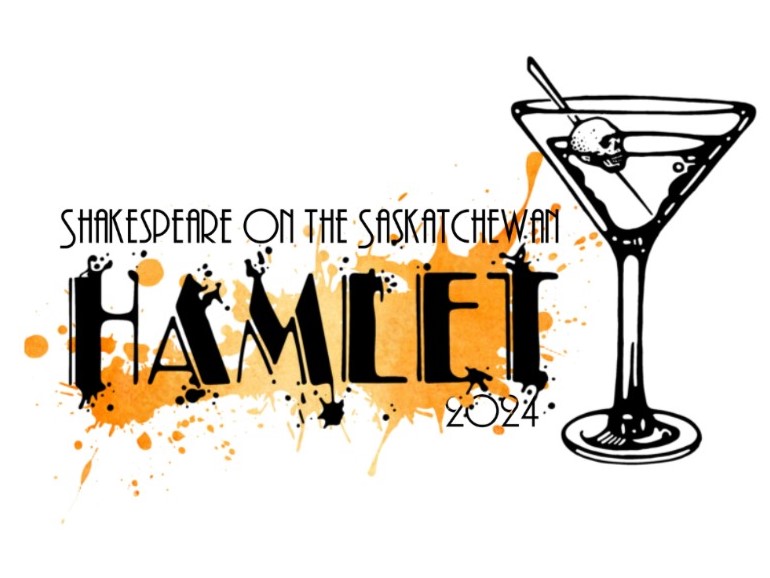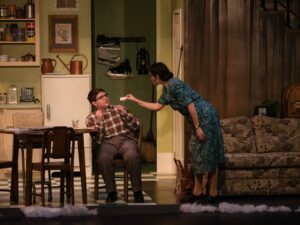If this is the future of Shakespeare on the Saskatchewan we get to look forward to, the company — and the theatre audience — is in good hands.
Glitz and glamour cast a veneer of decadence over the dark and ugly truths in Shakespeare on the Saskatchewan’s newest production of Hamlet, and it’s one of the best shows the company has put on the stage in recent memory.
Kudos to Kayvon Khoshkam, the artistic director for SOTS and the director of this version of Hamlet, for finding the best of what makes the company shine and polishing it to a mirror gleam. The theme of the roaring 20s is not only a magnificent aesthetic to draw from — with sharp suits and slick dresses alighting on each character and a stunning set of stark black and gold lending a very gaudy Gatsby-esque feel to the production — but also lends itself well to the twists and turns of Hamlet‘s dark revenge plots seething under a thin layer of exuberance and excess.
Khoshkam and the SOTS team deserves praise for finding a cast that so brilliantly fills their roles. Praneet Akilla was magnificent as a physical and eccentric Hamlet, mixing melancholy and madness well — particularly when playing against his fellow castmates.
Skye Brandon and Lisa Bayliss flourished as the ever-troubled power couple of King Claudius and Queen Gertrude. Brandon’s portrayal of a man struggling with the vile deeds he’s committed added a very human element to an erstwhile calculating villain, and Bayliss gave the troubled Gertrude a lovely depth of character as both a queen and a mother.
It’s hard not to highlight every single character in the show. Each performer had a chance to shine, and none of them were slouches. Philippa Williams and Grahame Kent made the forgettable characters of Rosencrantz and Guildenstern into some of the funniest parts of the production, and Kevin Williamson was pitch-perfect as the honest, earnest and long-winded Polonius.
It’s the integration of all the available elements — the cast, the theme, and the technology of the new SOTS space itself — where we see Khoshkam’s vision shine. Too many times in the past the theme of a SOTS show has been only a visual choice, a new and curious way to present a story many are already familiar with.
For Khoshkam, the theme was an integral part of the storytelling. Jazz music from the 20s and 30s constantly filled the space (often sung by the talented Kristel Harder), characters wielded guns as often as swords, and the “play within a play” that is one of Hamlet‘s hallmarks was displayed in — without spoiling the surprise — a masterfully creative and period-appropriate fashion.
The feelings of the era strike a chord with the Hamlet story, as well. As the world celebrates in colourful fashion, it is impossible to escape the harsh realities lying just below the surface. The 20s were a time of new technologies and new luxuries, of decadence concealing deep greed or post-war traumas beneath. In Hamlet, we see the titular character battling with his grief over his father’s death while the world parties around him — adding another intricate layer to the roaring 20s theme.
The show isn’t without flaws, but the nitpicks are certainly minor. The production utilizes the totality of the new SOTS space, incorporating light and sound elements that occasionally drowned out the cast on-stage or started and ended jarringly.
The show is long, more than three hours without even including the 15-minute pre-show “wedding celebration” of Claudius and Gertrude to draw the audience in. Modern Shakespeare shows are edited down anyways, and it felt like there was room to trim more of the proverbial fat from this show (“Brevity is the soul of wit,” as Polonius says).
The soliloquys during the show could’ve used a little more focus. The cast really shined when they had opportunities to feed off each others’ energy, and some of the (admittedly long and rambling) speeches were scattered out to the audience when they would’ve been better served to be more introspective, or directed to a particular unseen individual, rather than cast out to a swath of Saskatoon theatre-goers.
But let’s not get it twisted — the blemishes are slight. This is an artistic triumph for Shakespeare on the Saskatchewan. Not only does the production revitalize one of Shakespeare’s most popular tragedies, but it does so in a way that makes these works open and accessible to the audience.
Go see Hamlet. Get excited for the drama and the gleam and the fashion of the 20s, and let this talented cast carry your imagination away.






